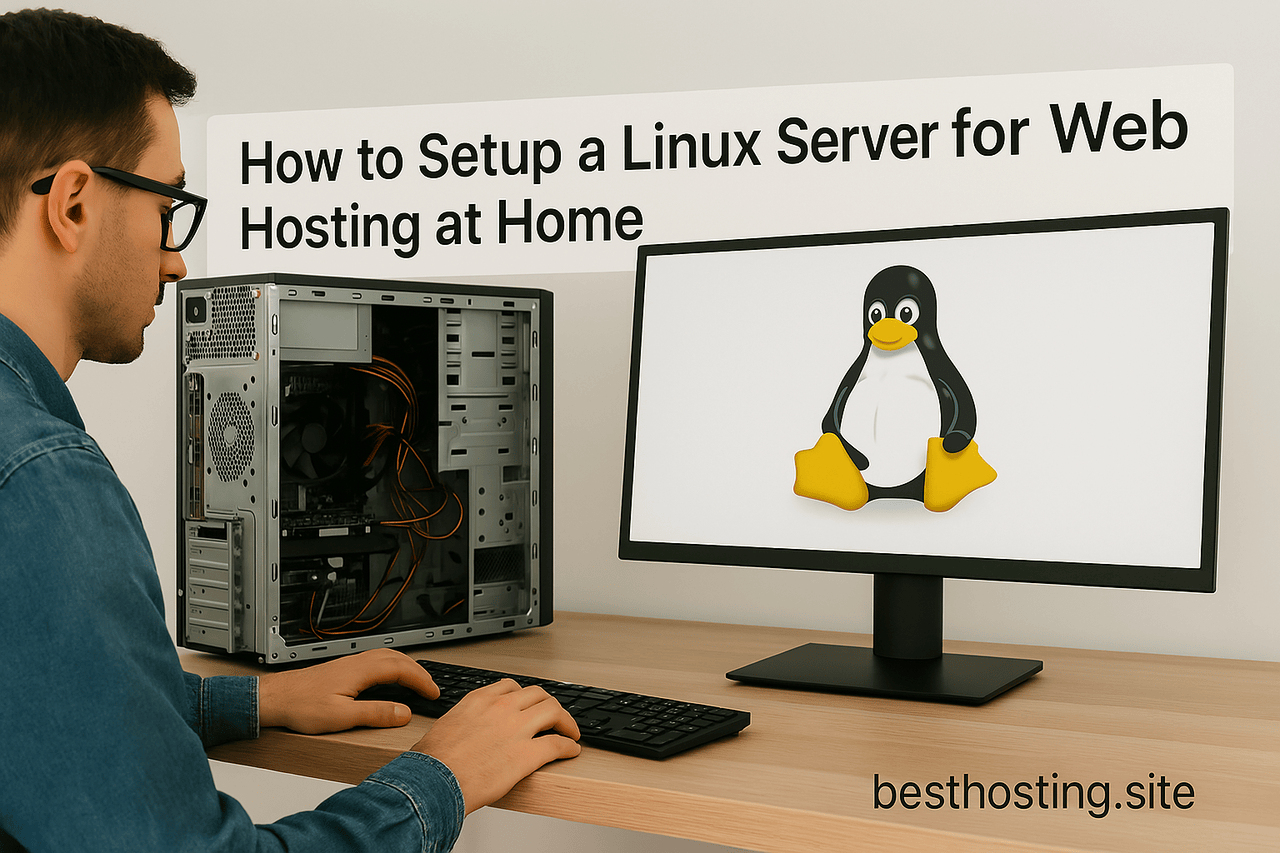Setting up your own Linux hosting home server might seem daunting, but it's actually more accessible than you think. Whether you want to host personal websites, learn server administration, or save money on hosting costs, this comprehensive guide will walk you through every step of creating a professional web hosting environment at home.

By the end of this tutorial, you'll have a fully functional Linux server capable of hosting multiple websites with proper security measures in place. Let's dive into the world of home web hosting!
What You'll Learn
This guide covers everything from hardware selection to advanced security configurations. You'll learn how to install and configure Apache web server, set up MySQL databases, implement SSL certificates, and secure your server against common threats. We'll also cover domain configuration, firewall setup, and troubleshooting common issues.
Hardware and Software Requirements
Minimum Hardware Requirements
CPU: Dual-core processor (2GHz or higher recommended)
RAM: 4GB minimum (8GB recommended for multiple websites)
Storage: 500GB hard drive (SSD recommended for better performance)
Network: Ethernet connection with stable internet (minimum 10 Mbps upload speed)
Router: Capable of port forwarding and static IP assignment

Software Requirements
Operating System: Ubuntu Server 22.04 LTS (recommended for beginners)
Web Server: Apache HTTP Server
Database: MySQL or MariaDB
Programming Language: PHP (for dynamic websites)
Security: UFW Firewall, SSL/TLS certificates
Step-by-Step Installation Guide
Step 1: Install Ubuntu Server
First, download Ubuntu Server 22.04 LTS from the official website and create a bootable USB drive. Install Ubuntu Server on your dedicated hardware with these considerations:
During installation:
• Choose “Install Ubuntu Server”
• Configure network settings with a static IP address
• Create a strong username and password
• Enable OpenSSH server for remote management
• Select “Install security updates automatically”
Step 2: Initial Server Configuration
After installation, log into your server and perform these essential updates:
sudo apt update && sudo apt upgrade -y
sudo rebootConfigure timezone and locale settings:
sudo timedatectl set-timezone America/New_York
sudo locale-gen en_US.UTF-8Step 3: Install Apache Web Server
Apache is the most popular web server software and perfect for beginners. Install it with:
sudo apt install apache2 -y
sudo systemctl start apache2
sudo systemctl enable apache2Verify the installation by checking the service status:
sudo systemctl status apache2
Step 4: Configure Firewall Security
Security is crucial for any web server. Configure UFW (Uncomplicated Firewall) to protect your server:
sudo ufw enable
sudo ufw allow ssh
sudo ufw allow 'Apache Full'
sudo ufw statusThis configuration allows SSH access and HTTP/HTTPS traffic while blocking all other incoming connections.
Step 5: Install MySQL Database Server
Most websites require database functionality. Install MySQL:
sudo apt install mysql-server -y
sudo mysql_secure_installationFollow the security script prompts to:
• Set a strong root password
• Remove anonymous users
• Disable remote root login
• Remove test database
Step 6: Install PHP
PHP enables dynamic content on your websites. Install PHP and essential modules:
sudo apt install php libapache2-mod-php php-mysql php-cli php-curl php-xml php-mbstring -y
sudo systemctl restart apache2Step 7: Configure Virtual Hosts
Virtual hosts allow you to host multiple websites on one server. Create your first virtual host:
sudo mkdir -p /var/www/yourdomain.com/public_html
sudo chown -R $USER:$USER /var/www/yourdomain.com/public_html
sudo chmod -R 755 /var/www/yourdomain.comCreate a sample index.html file:
echo "<h1>Welcome to yourdomain.com!</h1>" | sudo tee /var/www/yourdomain.com/public_html/index.html
Step 8: Network Configuration
Configure your router for external access:
Port Forwarding:
• Forward port 80 (HTTP) to your server's internal IP
• Forward port 443 (HTTPS) to your server's internal IP
• Forward port 22 (SSH) for remote management (optional)
Dynamic DNS Setup:
If you don't have a static public IP, use a dynamic DNS service like No-IP or DuckDNS to maintain consistent domain access.
Step 9: SSL Certificate Installation
Secure your websites with free SSL certificates from Let's Encrypt:
sudo apt install certbot python3-certbot-apache -y
sudo certbot --apache -d yourdomain.com -d www.yourdomain.comSet up automatic renewal:
sudo crontab -eAdd this line: 0 12 * * * /usr/bin/certbot renew --quiet
Security Best Practices
Essential Security Measures
Regular Updates: Keep your system updated with security patches:
sudo apt update && sudo apt upgrade -ySSH Key Authentication: Disable password authentication and use SSH keys:
ssh-keygen -t rsa -b 4096 -C "[email protected]"Fail2Ban Installation: Protect against brute force attacks:
sudo apt install fail2ban -y
sudo systemctl enable fail2ban
Advanced Security Configuration
Apache Security Headers: Add security headers to your Apache configuration:
sudo nano /etc/apache2/sites-available/000-default.confAdd these headers inside the VirtualHost block:
Header always set X-Content-Type-Options "nosniff"
Header always set X-Frame-Options "SAMEORIGIN"
Header always set X-XSS-Protection "1; mode=block"Common Mistakes and How to Avoid Them
Network Configuration Errors
Problem: Website not accessible from outside your network
Solution: Verify port forwarding rules in your router and check firewall settings. Ensure your domain points to your public IP address.
Permission Issues
Problem: “403 Forbidden” errors when accessing websites
Solution: Check file permissions and ownership:
sudo chown -R www-data:www-data /var/www/yourdomain.com/
sudo chmod -R 755 /var/www/yourdomain.com/SSL Certificate Problems
Problem: SSL certificate not working or expired
Solution: Verify certificate renewal cron job and check domain DNS settings. Use sudo certbot certificates to check certificate status.
Performance Optimization Tips
Apache Performance Tuning
Optimize Apache for better performance:
sudo nano /etc/apache2/apache2.confAdd these optimization settings:
KeepAlive On
MaxKeepAliveRequests 100
KeepAliveTimeout 5Enable Compression
Enable Gzip compression to reduce bandwidth usage:
sudo a2enmod deflate
sudo systemctl restart apache2
Monitoring and Maintenance
Log Monitoring
Regularly check system and Apache logs:
sudo tail -f /var/log/apache2/access.log
sudo tail -f /var/log/apache2/error.logAutomated Backups
Create automated backup scripts for your websites and databases:
#!/bin/bash
mysqldump -u root -p your_database > /backup/db_backup_$(date +%Y%m%d).sql
tar -czf /backup/website_backup_$(date +%Y%m%d).tar.gz /var/www/When to Consider Professional Hosting
While hosting at home is excellent for learning and small projects, consider professional hosting services for:
• High-traffic commercial websites
• Mission-critical applications requiring 99.9% uptime
• Applications needing advanced security compliance
• Global audience requiring content delivery networks
Professional Hosting Alternatives
If you decide professional hosting better suits your needs, consider these reliable options:
• Hostinger – Affordable shared hosting with excellent performance
• Kinsta – Premium managed WordPress hosting
• DreamHost – Reliable hosting with strong privacy focus
Frequently Asked Questions
1. What internet speed do I need for home web hosting?
For basic websites, a minimum of 10 Mbps upload speed is recommended. For high-traffic sites or media-heavy content, consider 50 Mbps or higher upload speeds. Remember that upload speed is more important than download speed for hosting.
2. Can I host multiple websites on one Linux server?
Yes, Apache virtual hosts allow you to host unlimited websites on a single server. Each website can have its own domain, SSL certificate, and configuration while sharing the same server resources.
3. Is it safe to host websites from home?
With proper security measures, home hosting can be safe. Essential precautions include regular updates, firewall configuration, strong passwords, fail2ban installation, and monitoring logs for suspicious activity.
4. How much does it cost to run a home web server?
Costs include electricity (approximately $5-15 monthly), internet service, and optional domain registration ($10-15 annually). Initial hardware costs vary but can often use existing computer equipment.
5. What happens if my home internet goes down?
Your websites will be inaccessible until internet service is restored. For mission-critical applications, consider professional hosting with guaranteed uptime SLAs or implement redundant internet connections.
6. Can I use a dynamic IP address for web hosting?
Yes, but you'll need a dynamic DNS service to maintain consistent domain access. Services like No-IP, DuckDNS, or your router's built-in dynamic DNS can automatically update your domain's IP address when it changes.
7. How do I troubleshoot website connectivity issues?
Check these common issues: firewall settings, port forwarding configuration, DNS resolution, Apache service status, and domain registration. Use online tools like “Can you see me?” to test external connectivity.
Advanced Configuration Options
Database Optimization
Optimize MySQL for better performance:
sudo nano /etc/mysql/mysql.conf.d/mysqld.cnfAdd these optimizations:
innodb_buffer_pool_size = 256M
query_cache_limit = 2M
query_cache_size = 64MContent Management System Installation
Install popular CMS platforms like WordPress:
cd /var/www/yourdomain.com/public_html
wget https://wordpress.org/latest.tar.gz
tar -xzf latest.tar.gz
mv wordpress/* ./
rm -rf wordpress latest.tar.gzSummary and Next Steps
Congratulations! You've successfully learned how to setup a Linux server for web hosting at home. This comprehensive guide covered everything from initial installation to advanced security configurations.
Key achievements:
• Installed and configured Ubuntu Server
• Set up Apache web server with virtual hosts
• Implemented essential security measures
• Configured SSL certificates for secure connections
• Optimized performance and established monitoring

Next steps for your Linux hosting home server:
• Implement automated backups for your websites and databases
• Set up monitoring tools to track server performance
• Explore content management systems like WordPress or Drupal
• Learn about load balancing for high-traffic scenarios
• Consider containerization with Docker for easier management
Remember that running a home web server is an excellent learning experience that provides valuable insights into server administration, networking, and web technologies. Start with simple static websites and gradually expand to more complex applications as your confidence grows.
For production websites requiring guaranteed uptime and professional support, consider transitioning to managed hosting solutions when your needs outgrow home hosting capabilities. The skills you've learned here will serve you well regardless of your hosting choice.
Happy hosting, and enjoy your journey into the world of Linux server administration!


